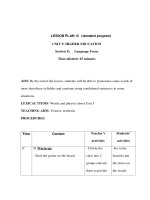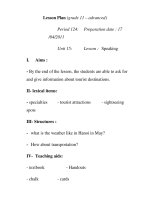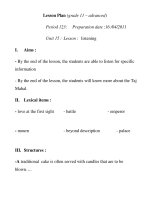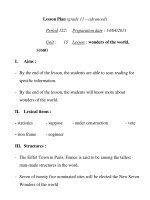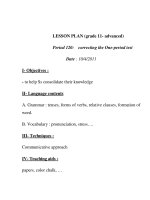talfc weak forms lesson plan
Bạn đang xem bản rút gọn của tài liệu. Xem và tải ngay bản đầy đủ của tài liệu tại đây (34.2 KB, 3 trang )
Talk a Lot
Foundation Course
Lesson 3 – Weak Forms – Lesson Plan
This lesson is divided into four parts and lasts around 50-60 mins. It is suitable for Pre-Intermediate level and above:
Part 1:
Q. How many words are there in the English language?
A. Over 2 billion (Source: Oxford Corpus)
Q. Do you know these thirty words? (Word List, below)
A. Yes, of course.
These words are in the top 100 most common words in written English, according to Oxford University – out of more
than two billion! “the” is the most common word in written English.
Q. What can you see here? What kind of words are there here?
A. Prepositions, articles, pronouns, auxiliary verbs, and conjunctions.
Q. What is the collective name for this kind of word?
A. Function words.
Q. Do you know how to pronounce these words?
A. Yes, of course.
Q. Can you read the thirty words out loud, please?
[A few students read the words out loud. In most cases they will pronounce the full form of each word, rather than the
weak form. Let the students make mistakes at this stage, without correcting them:]
Word List:
the
to
of
and
a
that
have
I
for
with
you
he
an
there
can
your
some
them
than
because
as
be
at
from
we
will
into
do
could
so
Part 2:
Q. Now – can you read the twelve phrases out loud, please?
[A few students read the phrases out loud. In most cases they will pronounce the full form of each function word in a
phrases, rather than the weak form, which will destroy the sentence stress. You might want to use just a few of the
phrases – e.g. four – depending on time. Let the students make mistakes at this stage, without correcting them:]
For more fun worksheets, games, and quizzes log onto www.englishbanana.com now!
Talk a Lot Foundation Course
English Banana.com
Lesson
3 Page 11
Talk a Lot
Foundation Course
Lesson 3 – Weak Forms – Lesson Plan
Phrases:
1. it is the first of May
2. work with a new partner
3. there is a bottle of milk on the table
4. some fish and chips in the park
5. do you want to go to the shop?
6. they are from the City of York
7. there is a book over there
8. could you give me a call in a minute?
9. the plane from Paris arrives at nine
10. we are going to be late
11. he has not got any money because he is broke
12. we will put the cake into a box
Let’s look at the first phrase: “it is the first of May”. Would I say it like that? [word by word] No. [Elicit the contraction
“it’s” and the two weak forms – th and uhv .]
Part 3:
At the beginning of the lesson, I asked you: “Do you know how to pronounce these words?” You all said yes, and you
read them out loud. But you pronounced each one [or, almost all of them] with their full form. How often do we need
to say any of these words individually? Almost never. We never need to say simply, “than”, or “from”! These words
are almost always in between a set of content words. These words are the glue, or the cement, of the sentence, that
keep the content words together. So, since we know how common these words are – in the top 100 out of over 2
billion! – is the mispronunciation of these words the main cause of your problems with pronunciation? It will
be well worth your while to learn the correct pronunciation of each one:
[If possible, try to elicit the weak forms from the students, and write them on the board alongside the original list,
using the NEA. Remind learners of the importance of the Schwa sound in unstressed syllables, which is written uh ,
and the glottal stop, which is written _ and usually replaces t at the end of a syllable:]
Word List:
the
to
of
and
a
that
have
I
for
with
you
he
an
there
can
th
t
uhv
uhn
uh
th_
uhv
uh
f
w
y
hi
uhn
th
kn
your
some
them
than
because
as
be
at
from
we
will
into
do
could
so
y
sm
thm
thn
b kz
uhz
bi
uh_
frm
wi
uhl
in t
d
kd
s
[The teacher could improvise short phrases to illustrate some of the weak forms, e.g. in “fish and chips” the word
“and” is reduced to uhn – the d sound is removed due to Elision (see Lesson 4), etc. As you go through each word
and its reduced form, emphasise the fact that in most cases the vowel sound is removed and only consonant sounds
– or the Schwa sound – is left, e.g. the word “can” loses its strong a sound, and we hear only the two consonant
sounds, which create a natural Schwa sound when we put them together.]
For more fun worksheets, games, and quizzes log onto www.englishbanana.com now!
Talk a Lot Foundation Course
English Banana.com
Lesson
3 Page 12
Talk a Lot
Foundation Course
Lesson 3 – Weak Forms – Lesson Plan
Part 4:
Now, armed with the knowledge of the correct pronunciation of each function word, let’s return to the phrases. First,
which words are stressed? Which word have the meaning? [i.e. the content words, underlined below] What happens
to the function words in between? How can we reduce them so that they are as weak as possible, without deleting
them – which would create a grammar error?]
[Students work on the task in pairs or small groups. If they are able to, they could write the NEA spelling of each
phrase. After a short time, the teacher goes through each sentence on the board, eliciting feedback from the
students. Pay particular attention to how the full form of function words, e.g. for changes to weak: f ]
Phrases:
1. it is the first of May
2. work with a new partner
3. there is a bottle of milk on the table
4. some fish and chips in the park
5. do you want to go to the shop?
6. they are from the City of York
7. there is a book over there*
i_ zth Fer st Vmei
Wer kw th Nyoo Par_ n
th z Bo_ uh l Vmil kon th Tei bl
sm Fi shn Chi psin th Park
j wo n Geu t th Shop?
th frm th Si_ ii y Vyork
th z Buu keu v Their
* the second “there” is an adverb. It is worth noting that function words at the end of a sentence should have full form (see notes)
8. could you give me a call in a minute?
9. the plane from Paris arrives at nine
10. we are going to be late!
11. he has not got any money because he is broke
12. we will put the cake into a box
k j Gi vmee y Kor li n Mi ni_?
th Plein frm Pa ri s Rai vz_ Nain
w g n bi Lei_?
hi Ya zn_ Go_ e nii Mu nii k zee Zbreuk
wl Puu_ th Kei kin t w Boks
Notes:
•
Some function words keep their full form when they are used at the end of a sentence, e.g. object
pronouns like “him”, “them”, and “us”. Also, the prepositions “in” and “on” don’t have weak from, but the n
sound at the end of each word is a friendly consonant sound (see Lesson 4), which enables a smooth
transition to the next sound.
•
Summary of the problem: students learn function words with their full form and a strong vowel sound, e.g.
a, and, at, etc. but not as part of a sentence. We hardly ever use function words individually, so students
use the full form in a sentence when they should use the weak form – which they have never formally
learned. So, change the strong vowel sound in a function word into a Schwa sound, or remove it
completely!
•
Where possible in spoken English, we use contractions with the weak forms, e.g. “Are you going to…?”
becomes uh y g n…? The main aim for speakers is to get to the content words – to the point of what we
are saying. Here are some very common contraction combos:
there is a…
into a…
do you…?
=
=
=
th z…
in t w
j…?
could you…?
because of…
it is the…
=
=
=
k j…?
b k z…
sth…
(we reduce “it is” to s because we are so used to this pattern that we don’t need to hear “it is” every time.
s is enough to communicate. And anyway, we want to get on to the point of the sentence – the content
words.)
could have
you are going to
=
=
k dv
ygn
(see also Levels of Reduction with Contractions, P.X)
•
These reductions work because our brains are programmed to understand these patterns, e.g. w for “we”.
There is only one pronoun that starts with w , etc.
For more fun worksheets, games, and quizzes log onto www.englishbanana.com now!
Talk a Lot Foundation Course
English Banana.com
Lesson
3 Page 13



